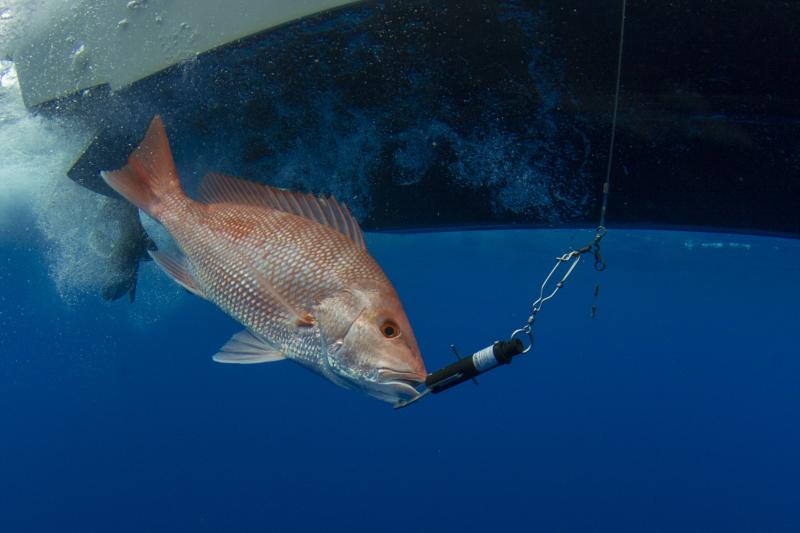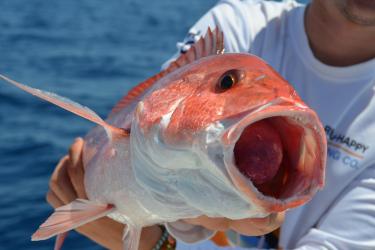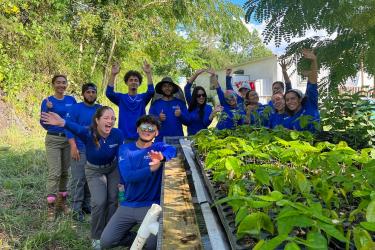NOAA’s Deepwater Horizon restoration partners at the Gulf States Marine Fisheries Commission selected three new partners to conduct studies on reef fish restoration in the Gulf of Mexico. They were chosen through a competitive process, and the awards total approximately $690,000.
These studies are contributing to a $30 million project to encourage anglers to use fish descending devices. These devices increase survival of reef fish experiencing barotrauma in the Gulf’s recreational fisheries approved by the Deepwater Horizon Open Ocean Trustees.
Barotrauma is damage caused by the rapid expansion of gases in fish that are caught in deeper water and quickly brought up to the surface. As the gases expand, they can damage the eyes, stomach, and other parts of the fish. This makes it difficult for them to swim back down and survive once released. Descending devices help fish by quickly releasing them at their normal depth, reducing the number of reef fish that die from catch and release fishing.
Coming to a Charter Boat (or Inbox) Near You
All three studies will focus on the use of descending devices to help fish return to their underwater habitats, away from predators. Anglers can help restore fish populations impacted by the Deepwater Horizon oil spill by using these devices.
The first two studies will be conducted offshore, working with close to 40 recreational charter boat captains. Captains will:
- Recapture fish previously tagged and released using descending devices, to increase understanding of survival rates
- Deploy underwater cameras to shed light on whether predators, like sharks, are targeting fish when they are released with descender devices
- Receive training on best practices while using descending devices
Gulf reef fish anglers should also be on the lookout for mail and email surveys from partners at Southwick Associates. These surveys will help the project team understand barriers to using descending devices. By participating in the studies, anglers will help inform future angler outreach and education methods.
Study Descriptions
Results from the three studies will contribute to restoration efforts that increase the health of reef fisheries impacted by the Deepwater Horizon oil spill, while improving angler experiences. The work will be carried out through 2025.
Determination of Predation Mortality, Barotrauma Survival, and Emigration Patterns for Catch-and-Released Red Snapper
- Partner: Dr. Stephen Szedlmayer, Auburn University School of Fisheries, Aquaculture, and Aquatic Sciences
- Award: $250,750
- Timeline: 20-month project, ends December 2022
A team from Auburn University will collaborate with eight charter vessel operators to better understand the survival rates of red snapper released with descending devices. The team will tag and release red snapper across a range of locations and depths off the coast of Alabama and Mississippi. Participating captains will return to the tagging sites within 2 to 4 weeks to recapture as many tagged fish as possible. A combination of different tagging methods will provide a robust evaluation of descending methods and their effect on red snapper survival.
Do Descender Devices Increase Opportunities for Depredation? A Gulf-wide Examination of Descender Device Depredation Rates and Depredating Species
- Partner: Dr. Marcus Drymon, Mississippi State University Coastal Research and Extension Center
- Award: $238,981
- Timeline: 32-month project, ends December 2023
Working with 30 charter boat captains, this study will document whether hooked reef fish are eaten by predators and which species are responsible. This team from Mississippi State University will train and incentivize captains across the Gulf of Mexico to use descending devices and film fish releases with cameras. The team will then analyze the video footage, and results will be used to inform best release practices and address depredation concerns with descended fish. The project team will make short videos to train captains on data collection processes and share project results with stakeholders.
Measuring Changes in Angler Awareness and Use of Fish Descending Devices
- Partner: Southwick Associates
- Award: $200,000
- Timeline: Baseline study in 2021, follow-up study in 2025.
Southwick Associates will assess recreational reef fish anglers’ current knowledge of fish descending devices. The goal is to establish an understanding of anglers’ perceptions about releasing reef fish and identify barriers to using descending gear. Understanding barriers will inform future education and outreach, and help anglers learn the advantages of best release practices. In 2025, the team will measure the change in anglers’ awareness and adoption of descending gear over time.
Improving Recreational Fish Survival is One Project Among Many Restoring Marine Resources After Deepwater Horizon
These studies are one part of a comprehensive $30 million project reducing barotrauma injuries and deaths in reef fish. The project also aims to increase successful use of fish descender devices by distributing them to recreational anglers and providing information on their use. Supplying fishermen with the tools and knowledge to minimize barotrauma-related fish death and injury will result in increased survival of species released during recreational fishing activities.
This barotrauma project was one of four fish restoration projects funded by the Deepwater Horizon Open Ocean Trustees’ 2019 $226 million restoration plan. The remaining 14 projects in the plan are restoring sea turtles, marine mammals, and deep-sea coral habitats.
Hundreds of fish species were exposed to oil during and after the Deepwater Horizon spill. The exposure killed fish larvae that would have grown and contributed to the food web and fisheries. It also impaired fish growth and reproduction and caused changes in reef fish communities. Recognizing these and other impacts, the settlement with BP included $380 million to help restore injuries to fish and water column invertebrates.
Video: Recompression Devices: Helping Anglers Fish Smarter





